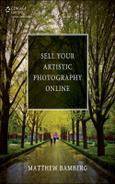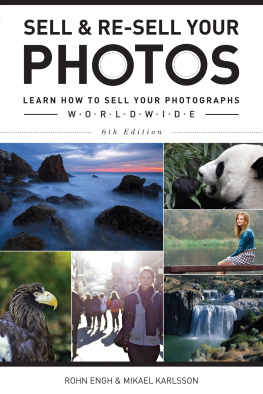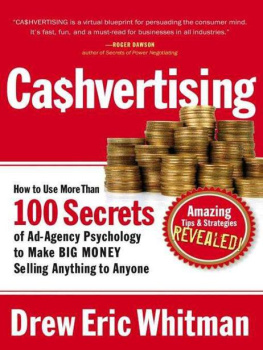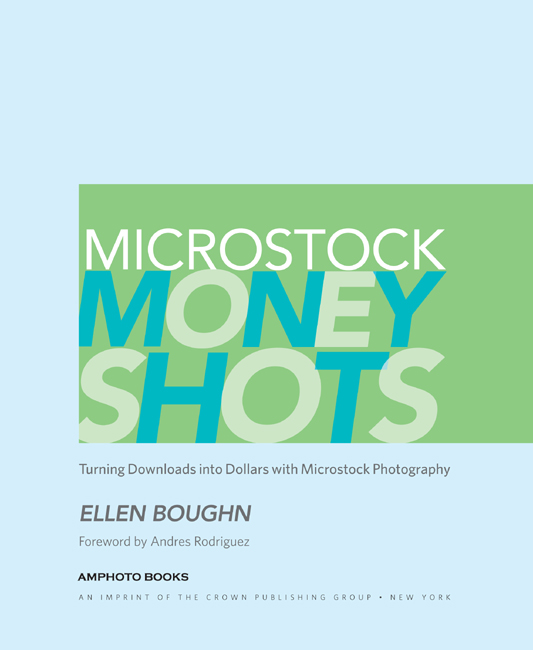
Cover photographs (clockwise from top left): Christian Wheatley/Shutterstock; Alena Ozerova/Shutterstock; Freezingpictures/Dreamstime; Regien Paasen/Shutterstock; Laurent Renault/Shutterstock; Valua Vitaly/Shutterstock
Text copyright 2010 by Ellen Boughn
All rights reserved.
Published in the United States by Amphoto Books, an imprint of the Crown Publishing Group, a division of Random House, Inc., New York.
www.crownpublishing.com
www.amphotobooks.com
AMPHOTO BOOKS and the Amphoto Books logo are registered trademarks of Random House, Inc.
Library of Congress Cataloging-in-Publication Data
Boughn, Ellen.
Microstock money shots : turning downloads into dollars with microstock photography / by Ellen Boughn ; foreword by Andres Rodriguez. 1st ed.
p. cm.
Includes index.
eISBN: 978-0-8174-3584-4
1. Stock photography. 2. Internet commerce. 3. Picture archiving and communication systems. I. Title.
TR690.6.B68 2010
770.2854678dc22
2010002543
v3.1

FOR EDDIE AND MAXX
Thanks go to Bob Kirschenbaum and Suzanne Goldstein, from whom I learned so much, and to Nancy Johnson for her lifelong support and friendship. A special acknowledgment is due to Serban Enache and Yuri Arcurs for educating me in the ways of microstock, and a super-huge thank-you to Lee Torrens for his advice, knowledge, and generous assistance in reading an early version of the manuscript. Andres Rodriguez is one of the busiest of microstock photographers, and I am very grateful to him for taking the time to provide his excellent foreword.
THERE ARE NO WORDS LARGE ENOUGH TO DESCRIBE WHAT I OWE TO MY HUSBAND, ED SMITH
CONTENTS
BY ANDRES RODRIGUEZ
Microstock is an exciting industry. Its constantly changing as new trends, services, and agencies arrive on the scene. You never know what will happen next and how it will change or affect the business. Microstock is also an industry of opportunity. For most people, getting started is not too difficult: The potential is high for anyone who thinks carefully about the opportunities and works hard to take advantage of them.
I started with microstock in 2004, when the industry was still very young. As a designer, I was buying photos to use on websites and in brochures for my company at the time. It wasnt long, however, before I started noticing how often each photo sold through the microstock agencies, which showed the number of downloads for each image. This is what first made me curious about the field.
For one design project, I needed a photo of a person designing a database structure. I wanted to see the persons face, so I imagined a photo in which the person appeared to be drawing the design on the screen. I searched all the top microstock agencies but could not find anything with this concept (at that time, the agency portfolios were much smaller than they are now). So I created the photo myself, and after using it in my design, uploaded it to some of the biggest microstock agencies. I was surprised at how often the photo sold. Clearly I was not the only person with a need for that particular subject matter. At the time I owned only a point-and-shoot camera and didnt know much about photography, so I wasnt too serious about pursuing more uploads just yet.
Eventually my job situation changed and I needed another way to earn a living. I had heard about a few people who were already professional microstock photographers, so I became inspired to try to make micro-stock photography my full-time job as well.
I purchased a book about photography fundamentals and bought my first digital SLR camera. Because I worked so hard to learn and practice as much as I could, I became frustrated after so many of my photos were initially rejected by microstock agencies. Digital noise was my first problem: Microstock agencies will reject images with even the smallest amount of noise, so I had to read about it and understand how to shoot photos that were totally noise-free. Then came problems with focus: If a photo is even slightly blurry, or the focus is not on the logical part of the photo, it will be rejected. Most of my photos were of people, so I had to practice getting the focus perfectly sharp and centered on the eyes of the model. It took a long time to figure out all the elements that agencies wanted and didnt want in a photo. Each time a photo was rejected, I paid attention to the reasons and adjusted my technique accordingly.
After a couple of months, I had gained a good understanding of how to make photos that agencies would accept. The next step was to figure out what made a photo a high seller. I started obsessing over sales stats and looking for common elements among my best-selling photos. I tried different lighting techniques, a variety of models, and a range of styles, from highly conceptual photos to simple shots. It took a couple of months, but I eventually found the combinations that worked best for salesspecifically, flat lighting, realistic but attractive models, and a clear message or concept. This knowledge was the key to reaching high sales. Now that I knew how to create high-selling photos, I could just increase the quantity to raise my earnings. I turned myself into a microstock shooting machine, shooting and uploading as many photos as I could as fast as I could.
After just a few months, I was earning as much as I had earned at my design job (though with all the hard work, it felt a lot longer than a few months!). The hard work was paying off, my earnings were rising quickly, and I continued to constantly improve the quality of my photos.
These days microstock is a different world. New microstock photographers need to start with much better photos than I did, but they also have a big advantage. They dont need to spend months figuring out how to create photos that microstock agencies will accept, nor must they spend months figuring out what kinds of photos sell wellthey have it all laid out here, in Ellens book.
That is not to say that it will be easy. This book will help you avoid many of the frustrations of figuring out what works in microstock, but you still have to put in the effort and invest the time to build a solid portfolio. Your success will equal the effort you put in. Just be sure to use this book to learn how to create high-selling photos before you run out and shoot too many: Your motto should be: Quality first, quantity second.
Like so many in the microstock industry, I have known Ellen for some years now. She has great experience in the stock photo industry and is an established authority on microstock. Shes the ideal person to write this book, and Im thrilled to finally be able to refer people to a comprehensive and high-quality guide to microstock photography.














